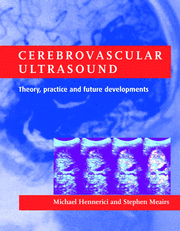Book contents
- Frontmatter
- Dedication
- Contents
- List of contributors
- Preface
- PART I ULTRASOUND PHYSICS, TECHNOLOGY AND HEMODYNAMICS
- PART II CLINICAL CEREBROVASCULAR ULTRASOUND
- PART III NEW AND FUTURE DEVELOPMENTS
- 25 Functional Doppler testing
- 26 Multigate emboli detection
- 27 Three- and four-dimensional cerebrovascular ultrasonography
- 28 Ultrasound contrast imaging
- 29 Ultrasonic thrombolysis
- Index
26 - Multigate emboli detection
from PART III - NEW AND FUTURE DEVELOPMENTS
Published online by Cambridge University Press: 05 July 2014
- Frontmatter
- Dedication
- Contents
- List of contributors
- Preface
- PART I ULTRASOUND PHYSICS, TECHNOLOGY AND HEMODYNAMICS
- PART II CLINICAL CEREBROVASCULAR ULTRASOUND
- PART III NEW AND FUTURE DEVELOPMENTS
- 25 Functional Doppler testing
- 26 Multigate emboli detection
- 27 Three- and four-dimensional cerebrovascular ultrasonography
- 28 Ultrasound contrast imaging
- 29 Ultrasonic thrombolysis
- Index
Summary
Introduction
Transcranial Doppler ultrasound (TCD) is now widely used as a method of detecting and counting cerebral emboli, particularly as they travel along the middle cerebral artery (MCA). The basic principle of the technique is that an embolus backscatters more ultrasonic power than the equivalent volume of blood that it displaces, and therefore careful monitoring of the power of the Doppler signal provides a means of detection. The characteristics of embolic signals are well known. Subjectively, they are described as sounding like a ‘snap’, a ‘chirp’, or a ‘moan’ (Ackerstaff et al., 1995) and as appearing on the Doppler sonogram as a short duration unidirectional high-intensity signal within the Doppler flow spectrum, occurring at random in the cardiac cycle (Spencer, 1992; Georgiadis et al., 1994). More objectively, they may be described as short duration (usually between 8 and 80 ms) amplitude modulated sine waves which exceed the level of the background blood flow signal by anywhere between 3 dB and 60 dB (Evans et al., 1997). For reasons that are not entirely understood, they may also exhibit significant frequency modulation (Smith et al., 1997a).
Ideally, investigators working in this area would like to be able to detect all the emboli travelling along the target artery and to characterize them in terms both of their size, and their composition (particularly as to whether they are solid or gaseous), but while considerable progress has been made in understanding the nature of embolic signals and their clinical correlates, even the superficially simple task of detecting and counting embolic signals still poses a challenge.
- Type
- Chapter
- Information
- Cerebrovascular UltrasoundTheory, Practice and Future Developments, pp. 360 - 373Publisher: Cambridge University PressPrint publication year: 2001
- 1
- Cited by



